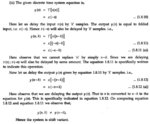Eshal
Advanced Member level 1
- Joined
- Aug 29, 2012
- Messages
- 470
- Helped
- 16
- Reputation
- 32
- Reaction score
- 15
- Trophy points
- 1,298
- Location
- Nowhere :)
- Activity points
- 5,149
Hello to all experts.
I understand how to check the DTS for shift variant and shift invariant.
But I am confused with this example:
Check for shift invariance for the below system.
y = x(-n)
= x(-n)
Attempted solution:
shift the input by k samples gives
y(n,k) = x(-n-k)
now shifting the output by k samples gives
y(n-k) = x(-n-k)
Hence y(n,k) = y(n-k)
So it is Shift Invariant system.
But book examples says something different that the given system is Shift Variant. See the image below of the book's example:

How does 1.8.11 and 1.8.12 come? I don't understand these equations.
Thank you ^_^
I understand how to check the DTS for shift variant and shift invariant.
But I am confused with this example:
Check for shift invariance for the below system.
y
Attempted solution:
shift the input by k samples gives
y(n,k) = x(-n-k)
now shifting the output by k samples gives
y(n-k) = x(-n-k)
Hence y(n,k) = y(n-k)
So it is Shift Invariant system.
But book examples says something different that the given system is Shift Variant. See the image below of the book's example:

How does 1.8.11 and 1.8.12 come? I don't understand these equations.
Thank you ^_^